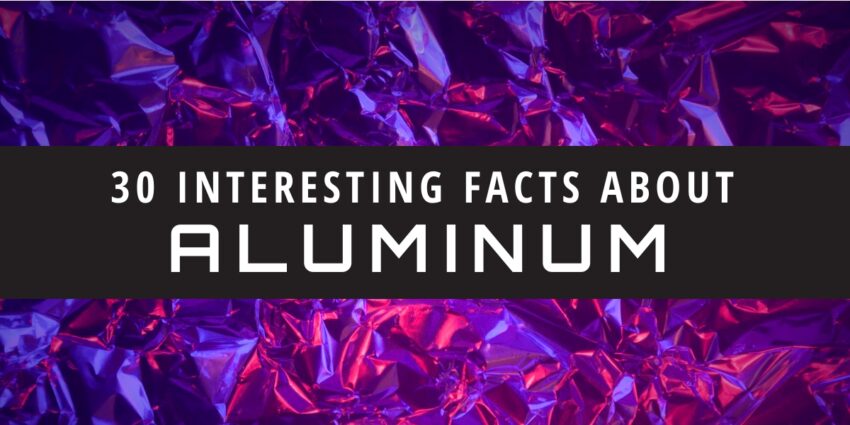Aluminum is lightweight, strong, corrosion-resistant, infinitely recyclable, and an essential part of our daily life. Measured either in quantity or value, aluminum’s use exceeds that of any other metal except iron, and it is important in virtually all segments of the world economy.
Beyond the basics above, what else should we know about aluminum? Check out the 30 interesting facts below!
- Aluminum forms in stars in a fusion reaction in which magnesium picks up an extra proton, according to Chemicool.
- Because of aluminium’s high likelihood of binding with oxygen, pure aluminium is almost never found in nature. However, aluminium is present in more than 270 minerals.
- Aluminum is the second most abundant metallic element in the Earth’s crust after silicon and 8% of the planet’s crust is aluminium. Not only that, but aluminum is the most abundant metal found naturally on Earth.
- Aluminium is globally the most used metal that does not contain iron.
- Australia is the leading producer of the world’s aluminium.
- Recycling aluminium requires only five percent of the energy that extracting it from ore requires.
- An aluminum can takes as little as 60 days to return as a new can after recycling.
- About 75 percent of all aluminum ever made is still in use, thanks to recycling.
- The by-product of aluminium production and recycling is called “white dross”.
- The Natural History by Pliny the Elder told the story of a first century craftsman presenting a cup made of an unknown metal looking like silver, but too light to be sliver, to Tiberius, the Roman Emperor.
- Ancient Greeks and Romans used aluminium compounds both as an astringent and a fabric dye.
- Alum, an aluminium-based salt, was used extensively in ancient times. Commander Archelaus discovered that wood was practically flame resistant if it was treated using an alum solution; protecting his wooden fortifications against flamed attack.
- Chou-Chu was a general of ancient China during the third century. Upon digging his tomb, historians found a piece of jewelry. 85% of the material of the jewelry was aluminum.
- Danish chemist Hans Christian Oersted first managed to extract aluminum from alum in 1825.
- For decades, aluminum was more highly prized than gold: Napoleon III, the first president of the French Second Republic beginning in 1848, proudly served his most honored guests using aluminum plates and cutlery because it was such a rare metal.
- On December 17, 1903, Wilbur and Orville Wright, American aircraft designers, flew a controlled aerial vehicle, the Flyer-1, for the first time in human history. They originally tried to use a car engine to propel the aeroplane, but it turned out to be too heavy. Therefore, a completely new engine with aluminium parts was developed specially for the Flyer-1. A light, 13-hp motor built with aluminum parts allowed the first ever plane to become airborne with Orville Wright at the helm for 12 seconds, flying 36.5 metres.
- Robert Victor Neher invented the method used for continuous aluminium rolling foil production in Switzerland in 1907. He launched the world’s first foil rolling mill in 1910.
- 1911: Tobler started to use foil for chocolate packing, still used to this day.
- The hull of the first all-metal plane, the Junkers J1, developed in 1915 by a world aircraft industry pioneer, the famous German aircraft designer Hugo Junkers, was made from Duralumin.
- The Empire State Building, which was the highest building worldwide until 1970, was built in 1931. It was the first building where aluminium was widely employed in construction, both in the basic structures and in the interior.
- 1941: With the onset of World War II, aluminum became a key strategic metal. Primary uses of aluminum included the construction of aircraft frames, ship infrastructure, radar chaff and millions of mess kits. America’s supply of bauxite and readily available electricity for primary metal production resulted in soaring output that eventually topped the production levels of all of the Axis countries combined. On the homefront, aluminum recycling got an early start. “Tin foil drives” included an offer of free movie tickets in exchange for aluminum foil balls. Joseph Stalin, the leader of the USSR, wrote to Franklin Roosevelt, the President of the USA, in 1941: ‘Give me 30 thousand tonnes of aluminium, and I will win the war’.
- In 1957, the USSR launched the first artificial satellite into orbit. The satellites hull consisted of two separate aluminium semi-spheres joined together. All subsequent space vehicles were produced using aluminium.
- The aluminium can, an iconic product that became one of the largest aluminium commodities, the symbol of environmental friendliness and a focal point in the field of art and design, emerged in the USA in 1958. Coca-Cola and Pepsi started to sell their drinks in aluminium cans in 1967.
- Energy required to produce new aluminum is down more than a quarter since 1995 and the industry’s carbon footprint is down nearly 40 percent.
- In 2018, transportation applications accounted for 40% of U.S. aluminum consumption; the remainder was used in packaging, 19%; building, 14%; electrical, 9%; consumer durables, 8%; machinery, 7%; and other, 3%.
- In 2018, aluminum recovered from old scrap in the U.S. was equivalent to about 28% of consumption.
- Aluminum reflects about 98% of infrared rays and about 92% of visible light.
- Rubies, emeralds and sapphires have a very high crystalline aluminium compound content
- Aluminum offers unrivaled barrier properties and can block out moisture, bacteria, microorganisms, light, oxygen and other gases. For this reason, aluminum foil is used in the protective packaging of pharmaceuticals.
- Pound for pound, aluminum absorbs twice the crash energy of steel and performs as well in an accident.
